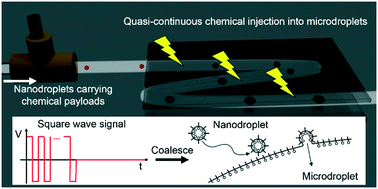Our official English website, www.x-mol.net, welcomes your
feedback! (Note: you will need to create a separate account there.)
Electrically controlled mass transport into microfluidic droplets from nanodroplet carriers with application in controlled nanoparticle flow synthesis†
Lab on a Chip ( IF 6.1 ) Pub Date : 2018-03-28 00:00:00 , DOI: 10.1039/c8lc00114f Tonghan Gu 1, 2, 3, 4 , Cao Zheng 1, 2, 3, 4 , Fan He 1, 2, 3, 4 , Yunfei Zhang 1, 2, 3, 4 , Saif A. Khan 5, 6, 7 , T. Alan Hatton 1, 2, 3, 4
Lab on a Chip ( IF 6.1 ) Pub Date : 2018-03-28 00:00:00 , DOI: 10.1039/c8lc00114f Tonghan Gu 1, 2, 3, 4 , Cao Zheng 1, 2, 3, 4 , Fan He 1, 2, 3, 4 , Yunfei Zhang 1, 2, 3, 4 , Saif A. Khan 5, 6, 7 , T. Alan Hatton 1, 2, 3, 4
Affiliation

|
Microfluidic droplets have been applied extensively as reaction vessels in a wide variety of chemical and biological applications. Typically, once the droplets are formed in a flow channel, it is a challenge to add new chemicals to the droplets for subsequent reactions in applications involving multiple processing steps. Here, we present a novel and versatile method that employs a high strength alternating electrical field to tunably transfer chemicals into microfluidic droplets using nanodroplets as chemical carriers. We show that the use of both continuous and cyclic burst square wave signals enables extremely sensitive control over the total amount of chemical added and, equally importantly, the rate of addition of the chemical from the nanodroplet carriers to the microfluidic droplets. An a priori theoretical model was developed to model the mass transport process under the convection-controlled scenario and compared with experimental results. We demonstrate an application of this method in the controlled preparation of gold nanoparticles by reducing chloroauric acid pre-loaded in microfluidic droplets with L-ascorbic acid supplied from miniemulsion nanodroplets. Under different field strengths, L-ascorbic acid is supplied in controllable quantities and addition rates, rendering the particle size and size distribution tunable. Finally, this method also enables multistep synthesis by the stepwise supply of miniemulsions containing different chemical species. We highlight this with a first report of a three-step Au–Pd core–shell nanoparticle synthesis under continuous flow conditions.
中文翻译:

电控制的质量传输,将其从纳米液滴载体转移到微流体液滴中,并应用于受控的纳米颗粒流合成†
微流体液滴已广泛用作反应容器,广泛用于各种化学和生物学应用中。通常,一旦在流道中形成液滴,向涉及多个处理步骤的应用中的后续反应中向液滴中添加新的化学物质是一个挑战。在这里,我们提出了一种新颖而通用的方法,该方法采用高强度交流电场,以纳米液滴为化学载体将化学药品可调谐地转移到微流体液滴中。我们表明,连续和循环猝发方波信号的使用都可以对添加的化学物总量进行极其灵敏的控制,同样重要的是,还可以控制化学物质从纳米液滴载体到微流体液滴的添加速度。一个先验建立了理论模型,以对流控制的情况下模拟运输过程,并与实验结果进行了比较。我们证明了该方法在金纳米颗粒的可控制备中的应用,方法是通过使用微乳液纳米液滴提供的L-抗坏血酸来减少微流体液滴中预装的氯金酸。在不同的场强下,L-抗坏血酸的数量和添加速率可控,从而可调节粒度和粒度分布。最后,该方法还可以通过逐步提供包含不同化学物种的细乳液来进行多步合成。我们通过在连续流动条件下进行三步Au-Pd核-壳纳米粒子合成的第一个报告来重点介绍这一点。
更新日期:2018-03-28
中文翻译:

电控制的质量传输,将其从纳米液滴载体转移到微流体液滴中,并应用于受控的纳米颗粒流合成†
微流体液滴已广泛用作反应容器,广泛用于各种化学和生物学应用中。通常,一旦在流道中形成液滴,向涉及多个处理步骤的应用中的后续反应中向液滴中添加新的化学物质是一个挑战。在这里,我们提出了一种新颖而通用的方法,该方法采用高强度交流电场,以纳米液滴为化学载体将化学药品可调谐地转移到微流体液滴中。我们表明,连续和循环猝发方波信号的使用都可以对添加的化学物总量进行极其灵敏的控制,同样重要的是,还可以控制化学物质从纳米液滴载体到微流体液滴的添加速度。一个先验建立了理论模型,以对流控制的情况下模拟运输过程,并与实验结果进行了比较。我们证明了该方法在金纳米颗粒的可控制备中的应用,方法是通过使用微乳液纳米液滴提供的L-抗坏血酸来减少微流体液滴中预装的氯金酸。在不同的场强下,L-抗坏血酸的数量和添加速率可控,从而可调节粒度和粒度分布。最后,该方法还可以通过逐步提供包含不同化学物种的细乳液来进行多步合成。我们通过在连续流动条件下进行三步Au-Pd核-壳纳米粒子合成的第一个报告来重点介绍这一点。











































 京公网安备 11010802027423号
京公网安备 11010802027423号